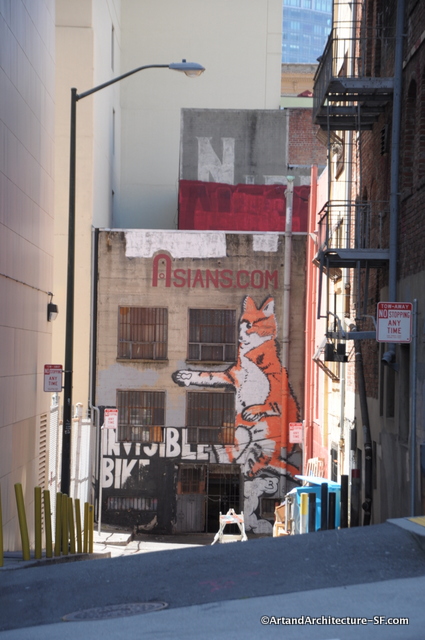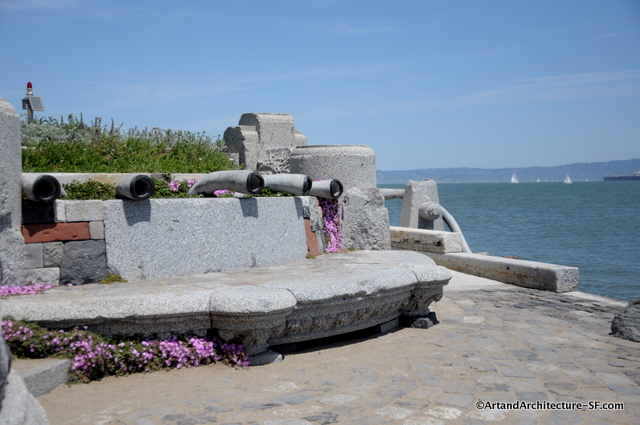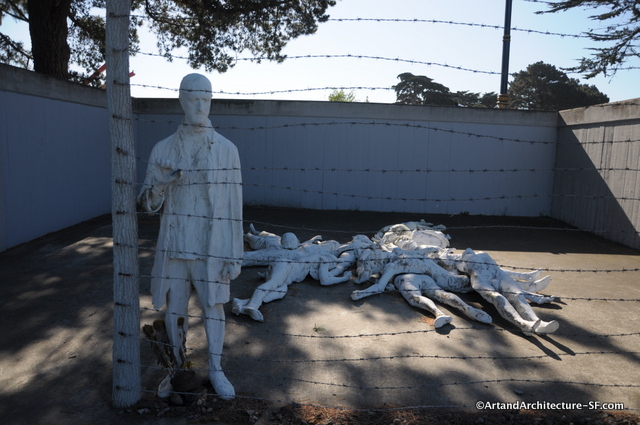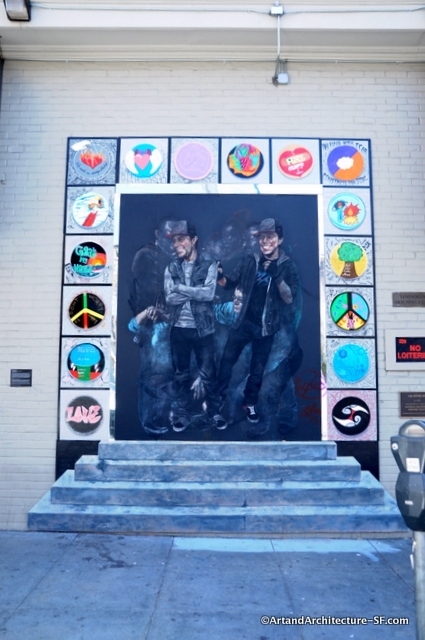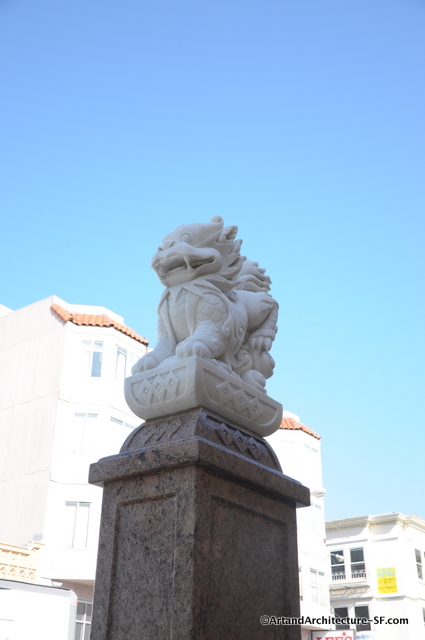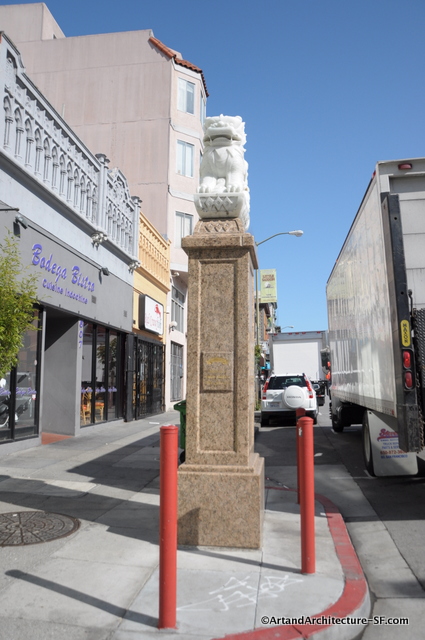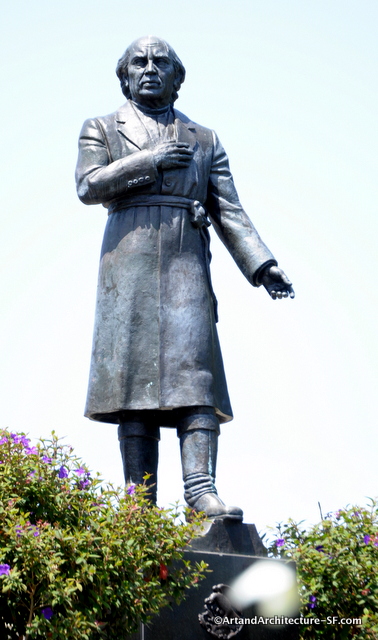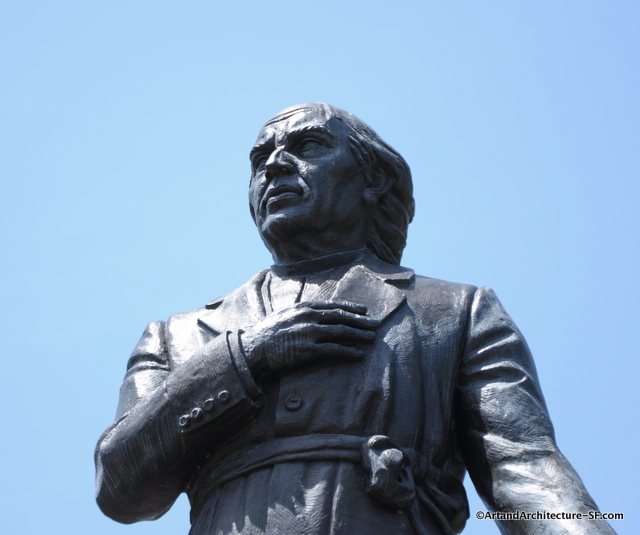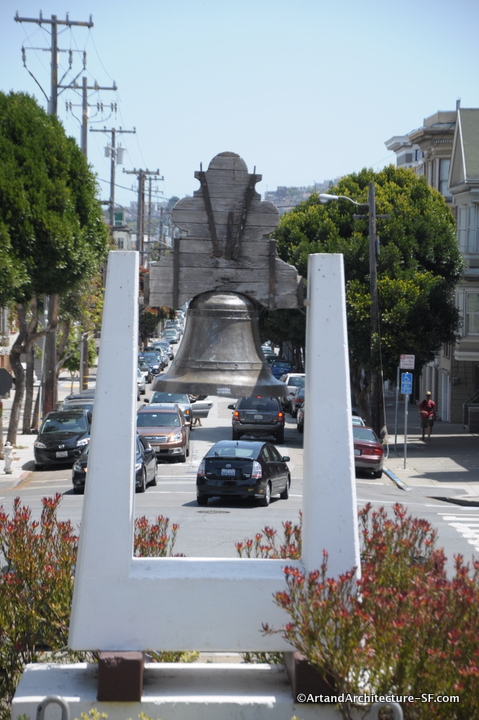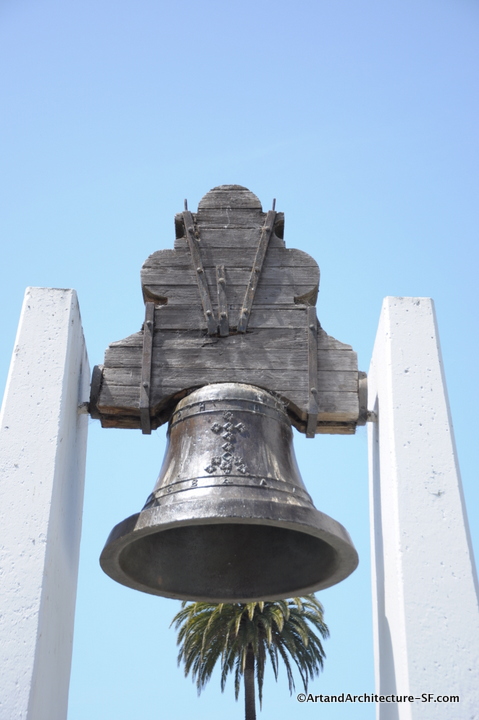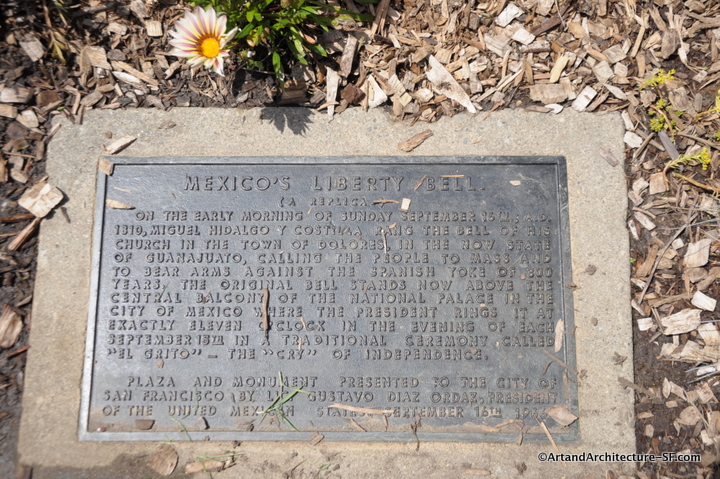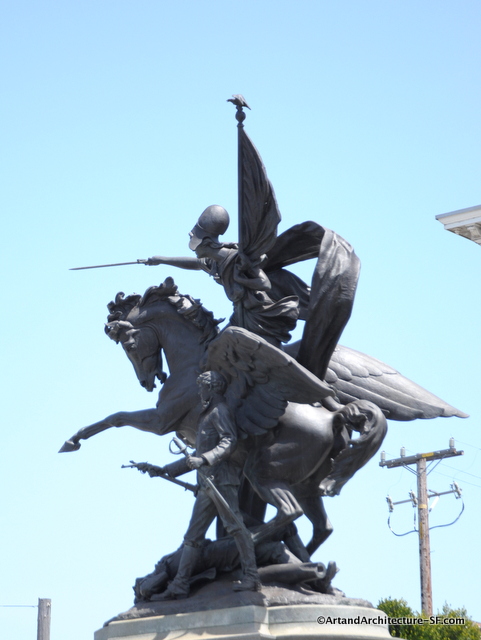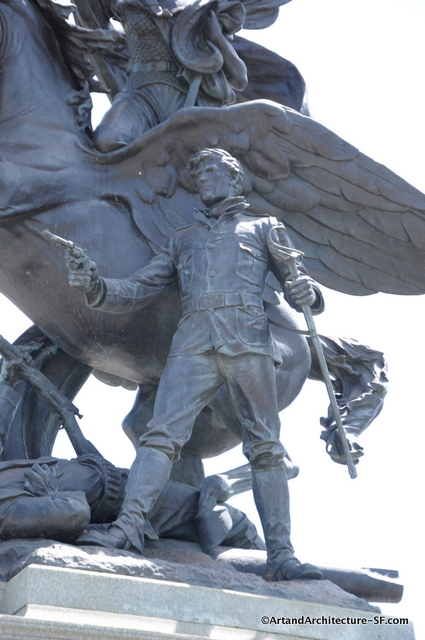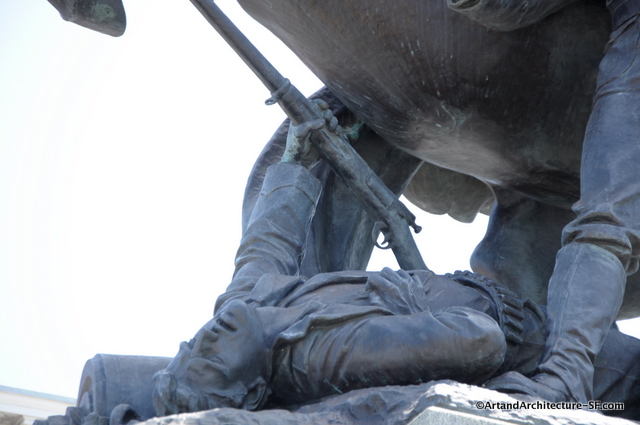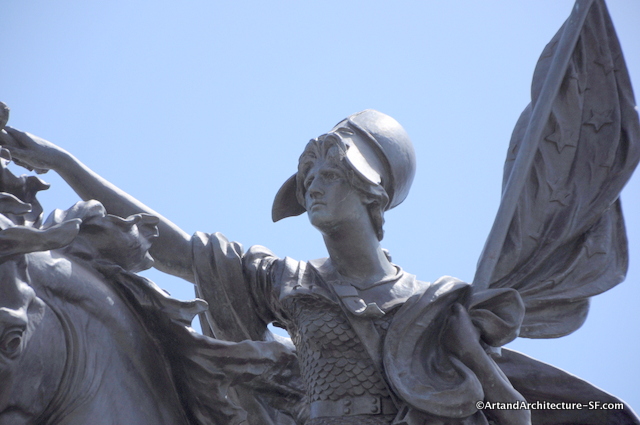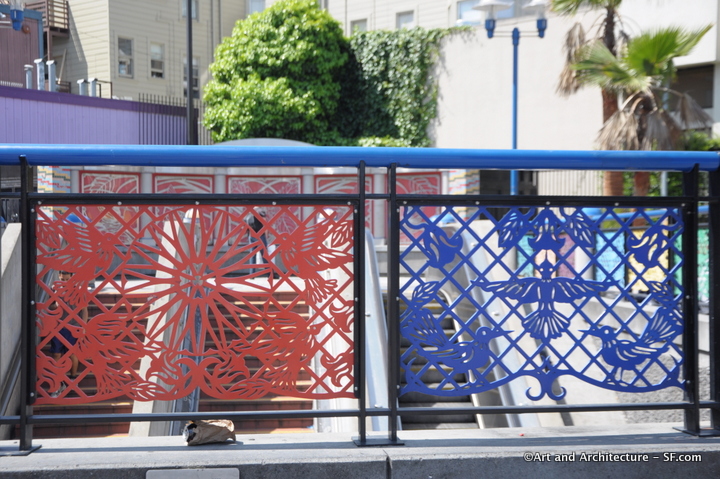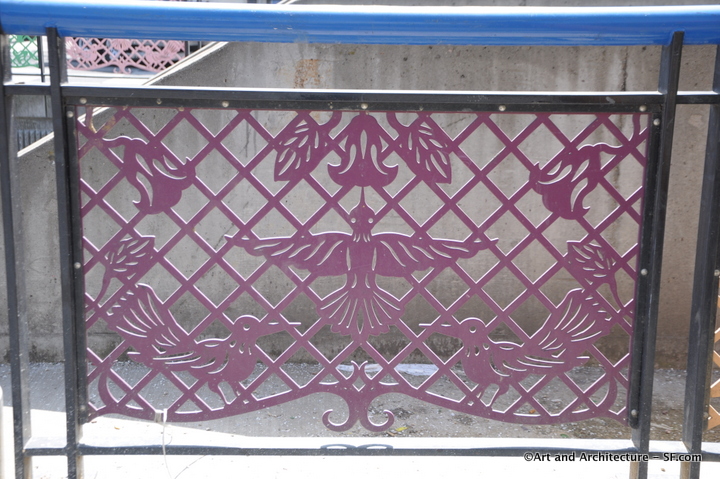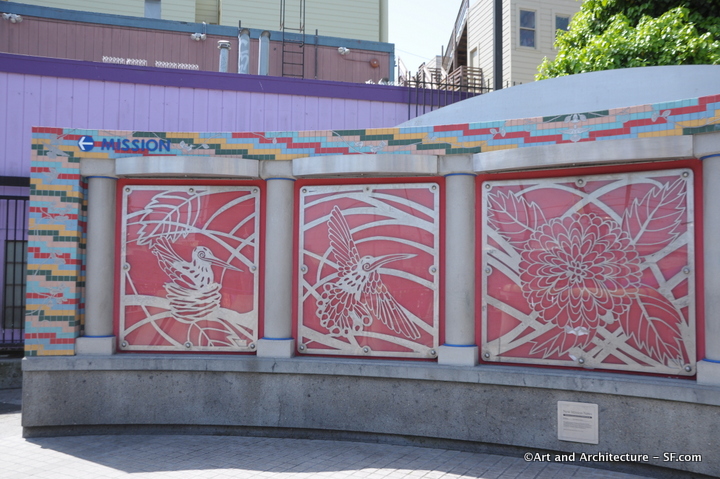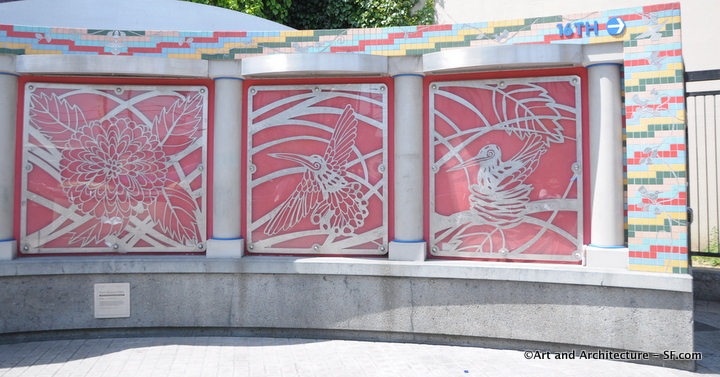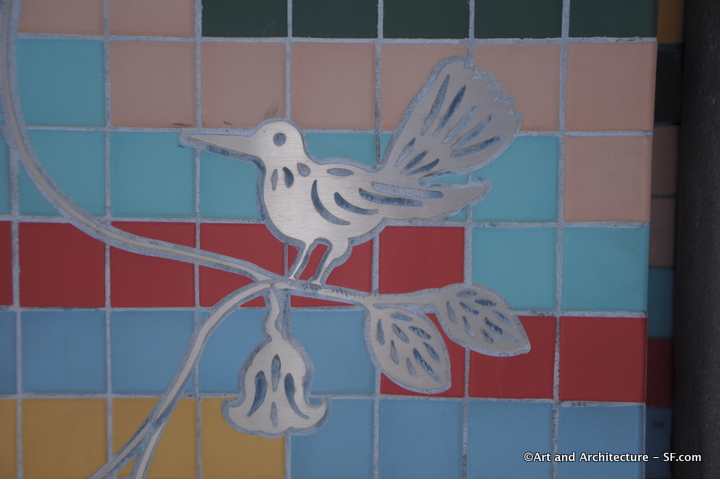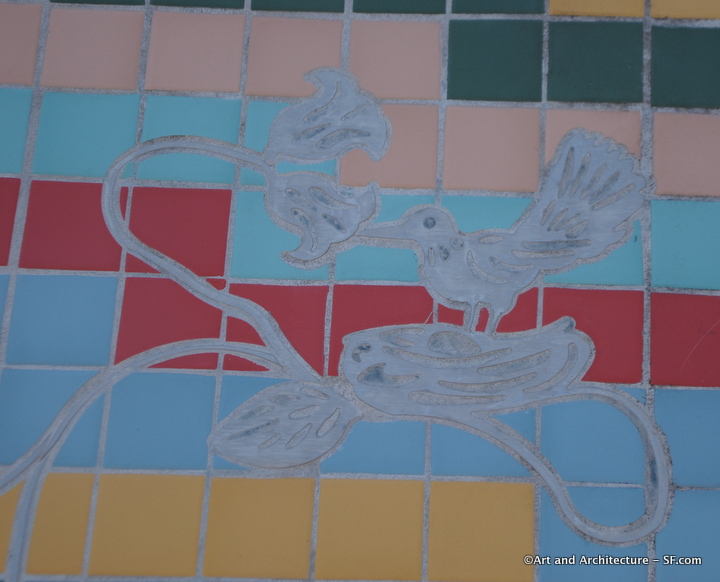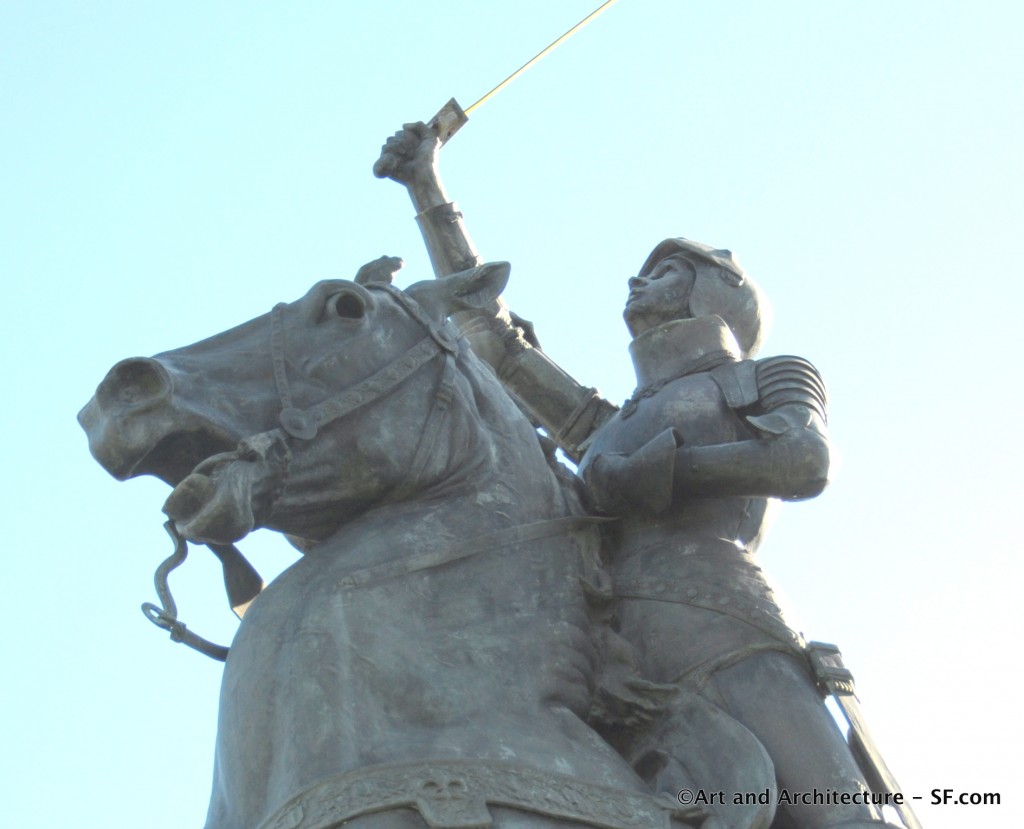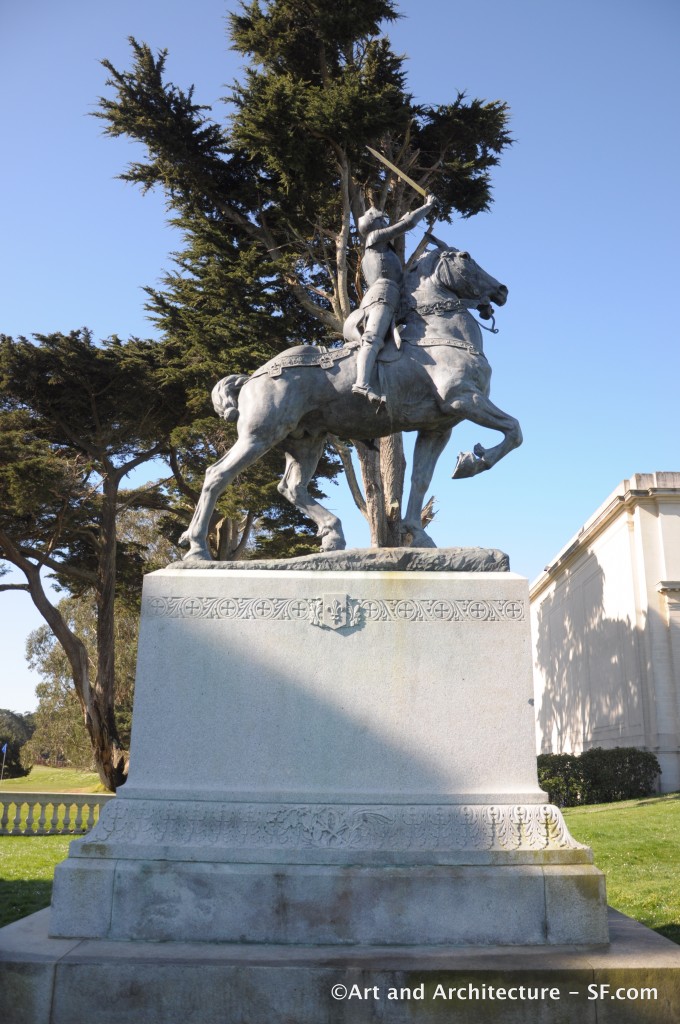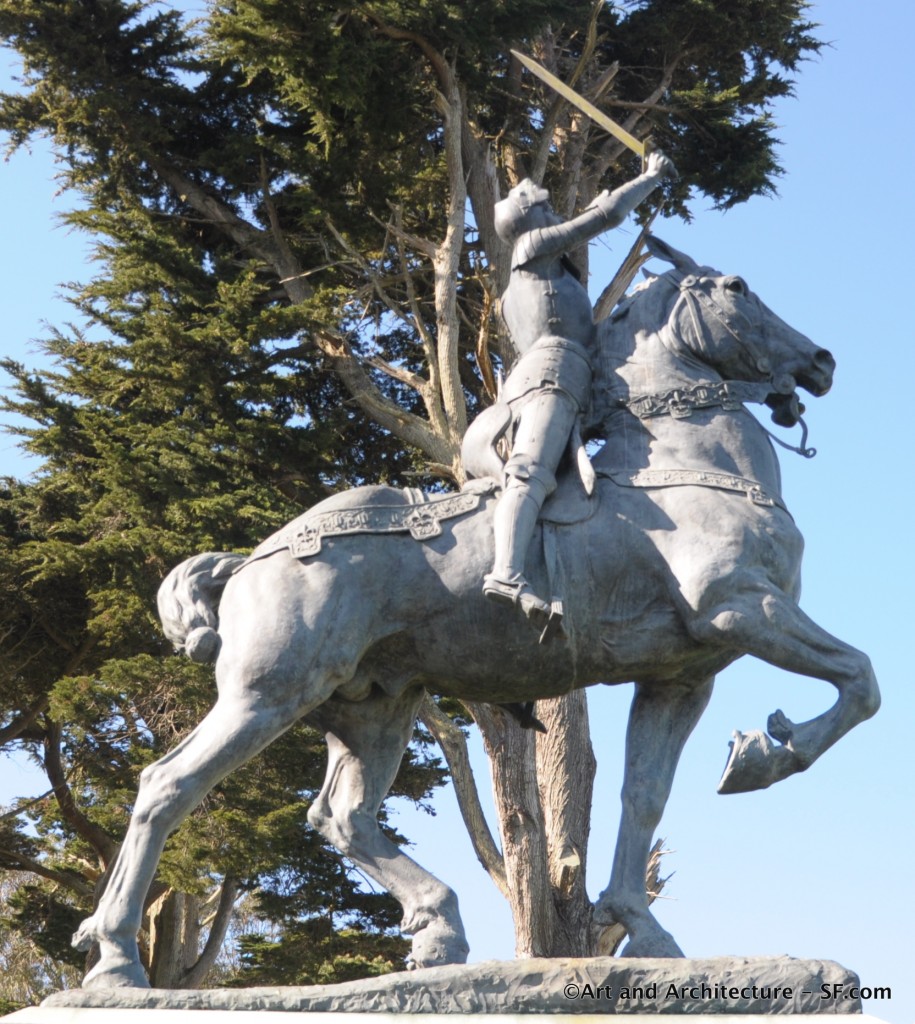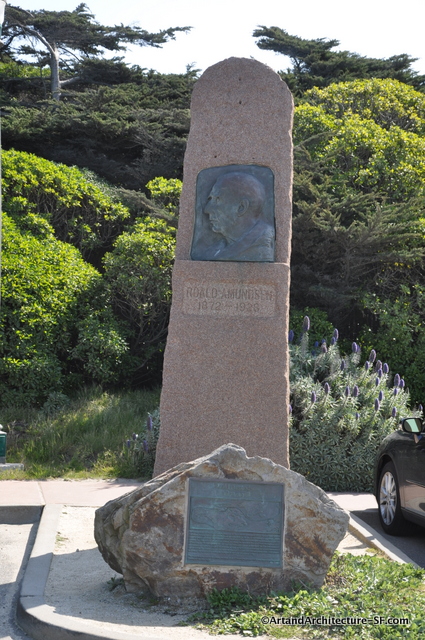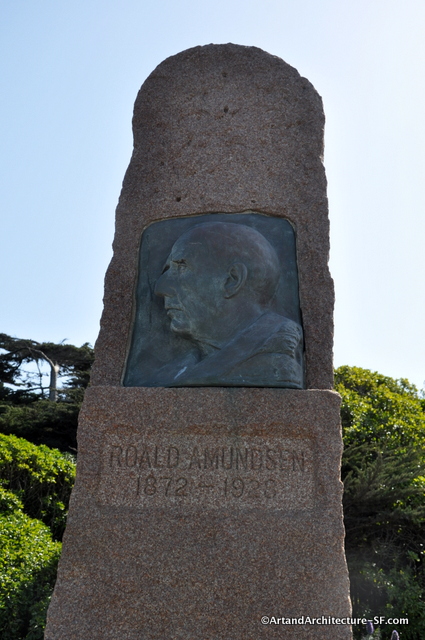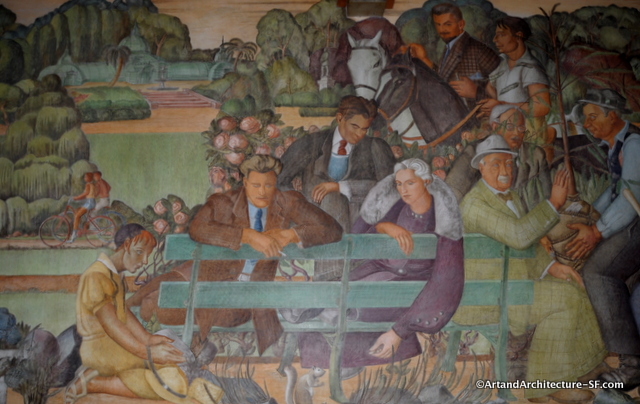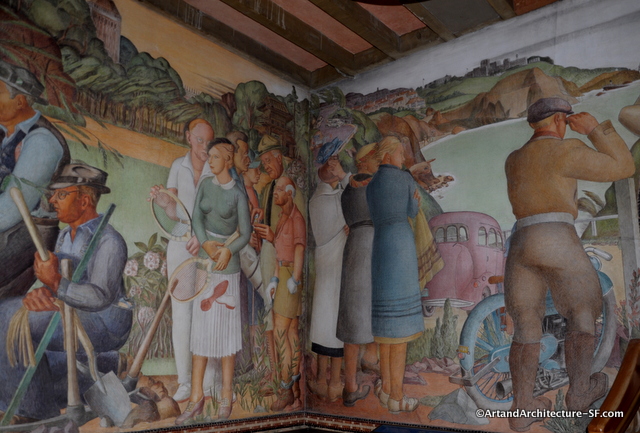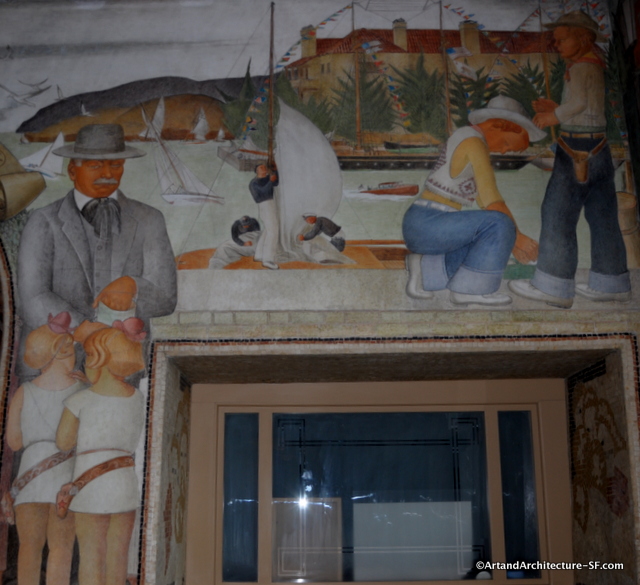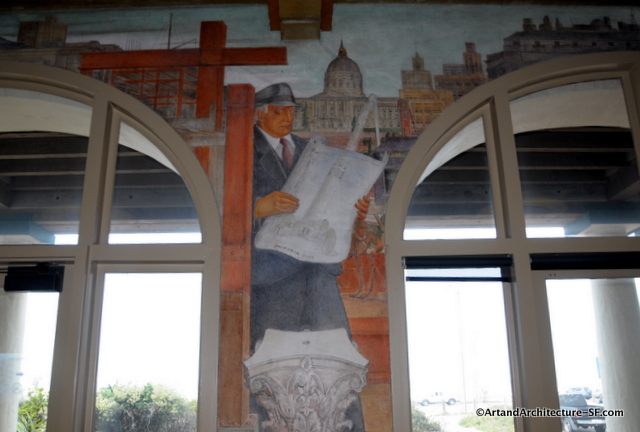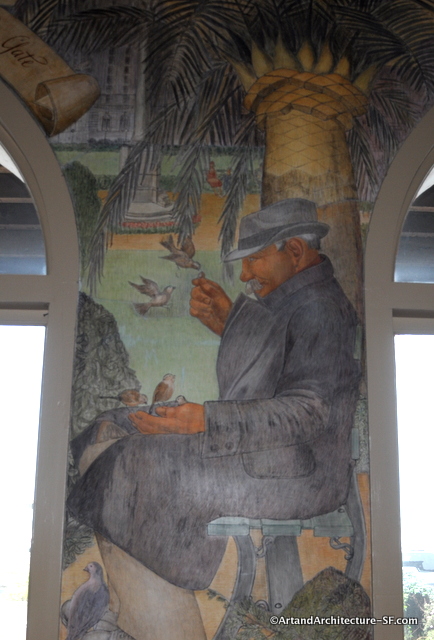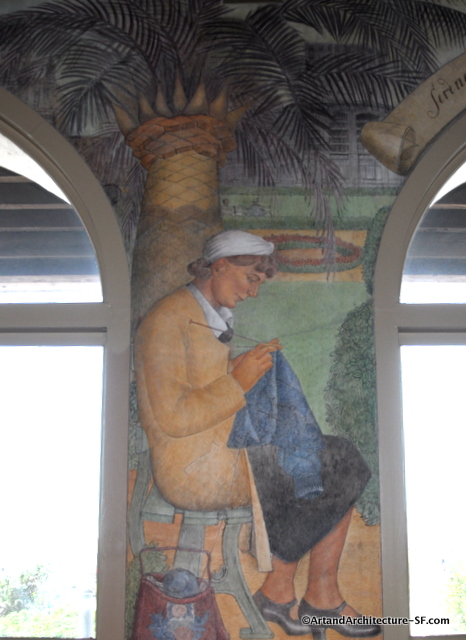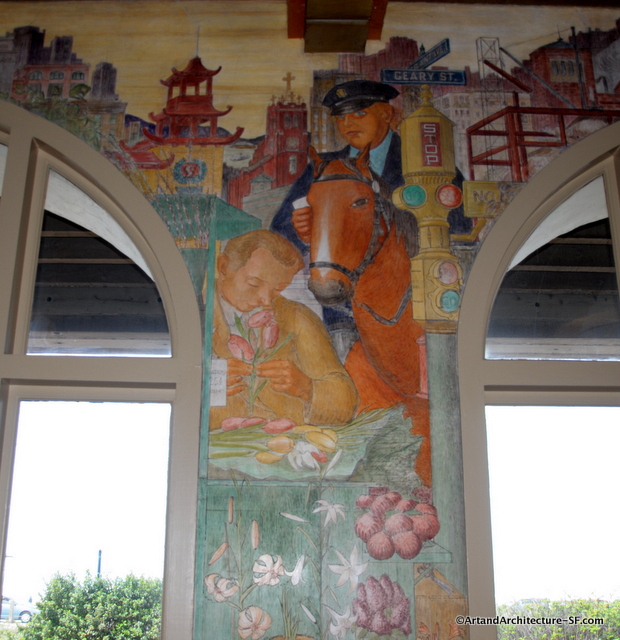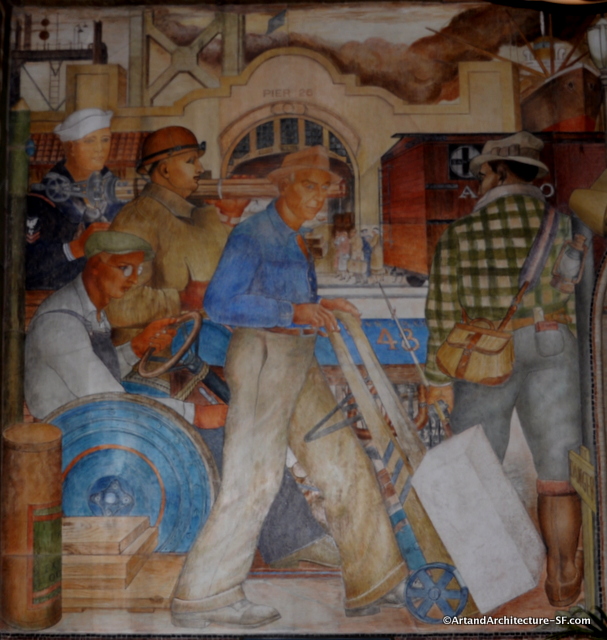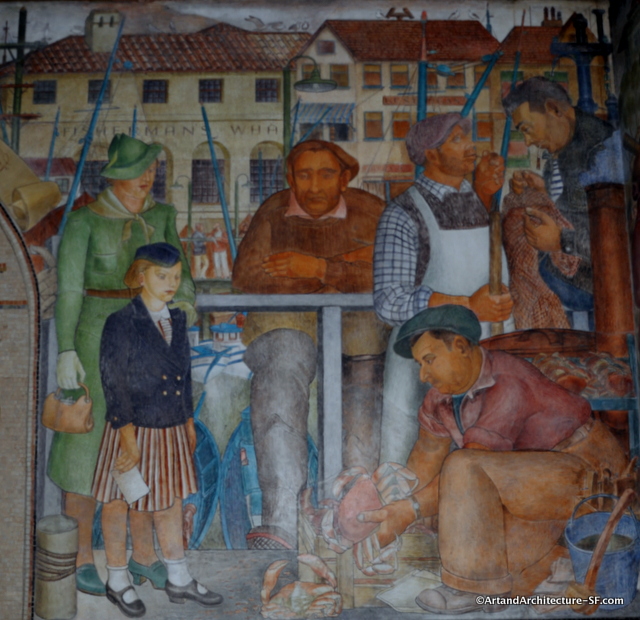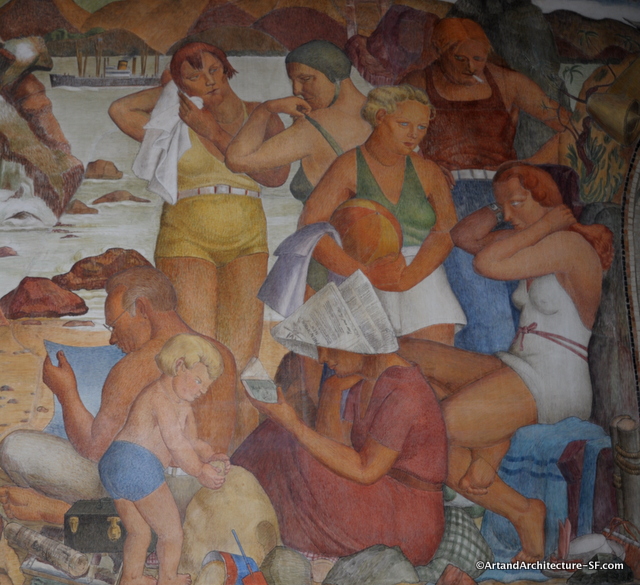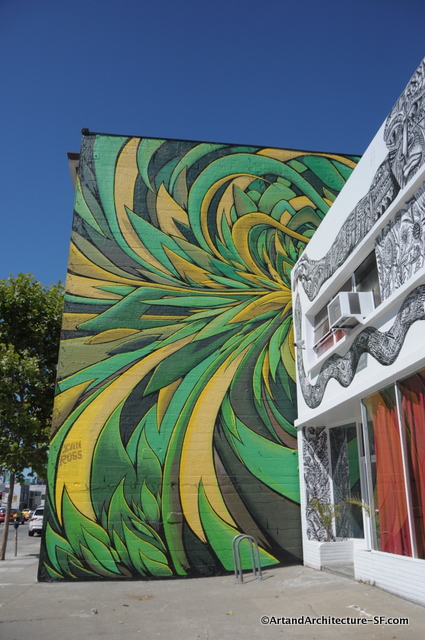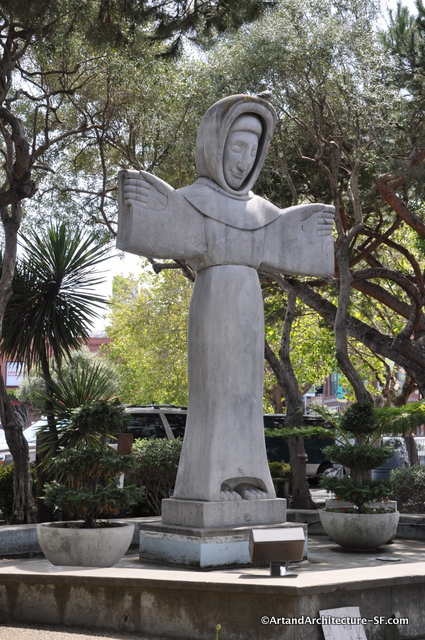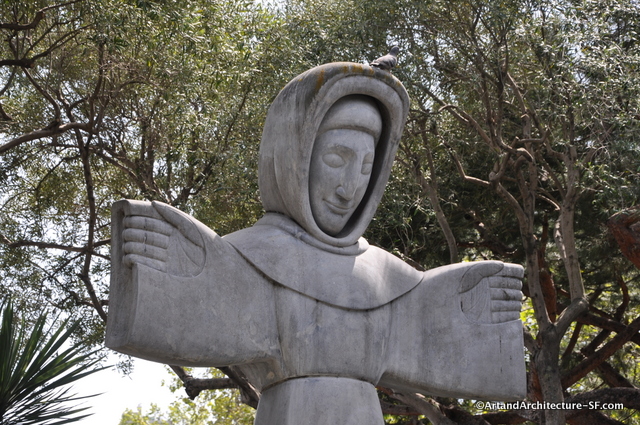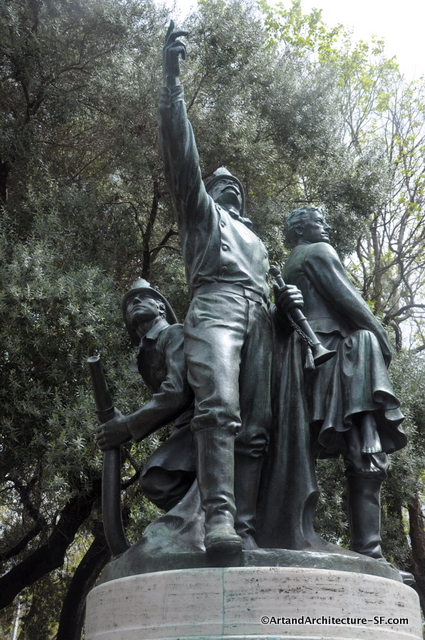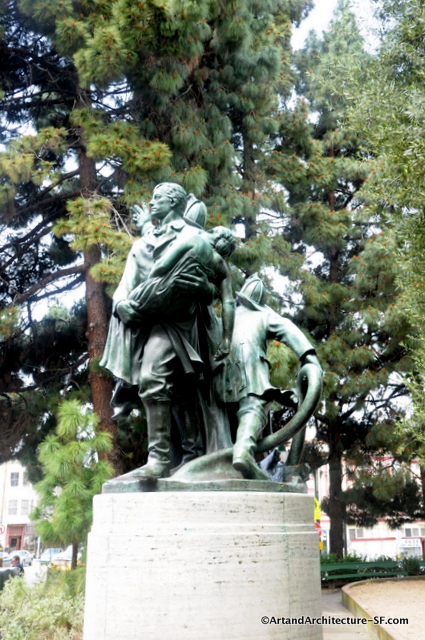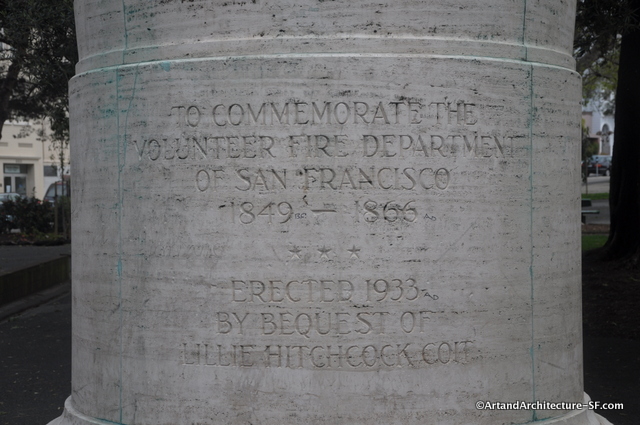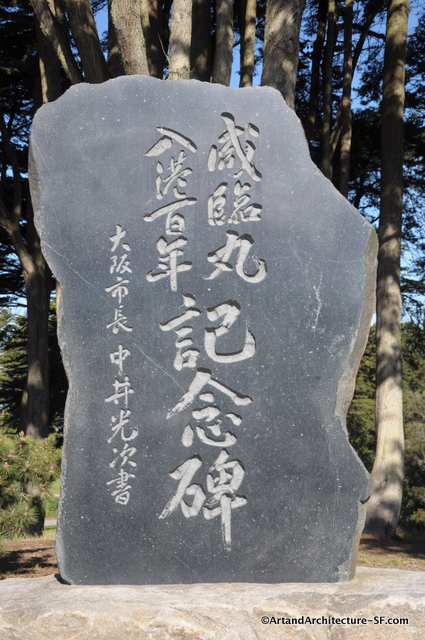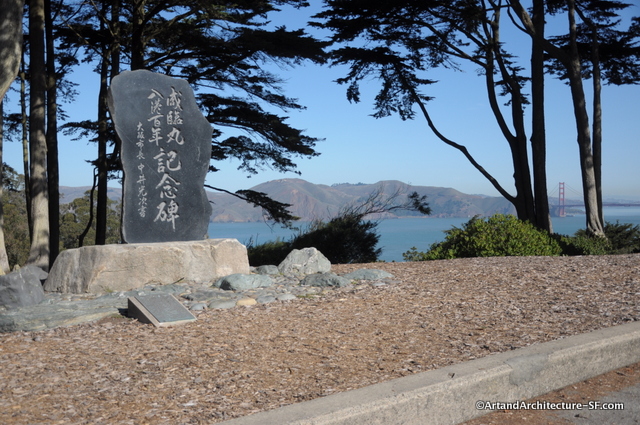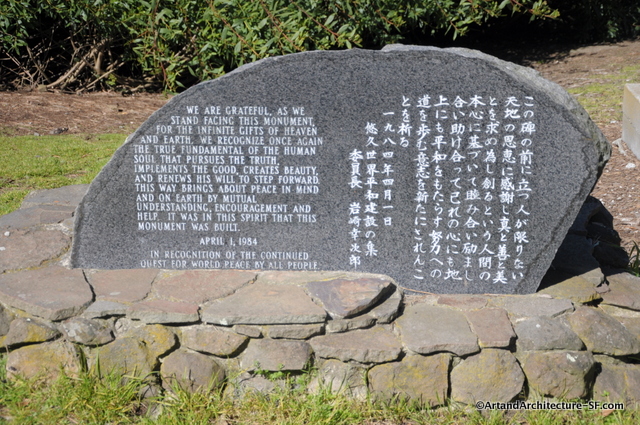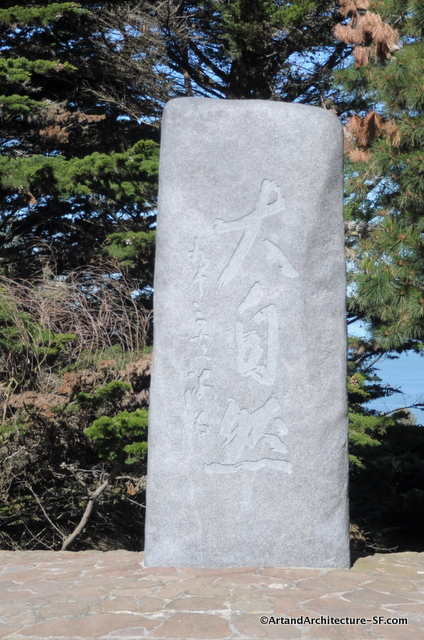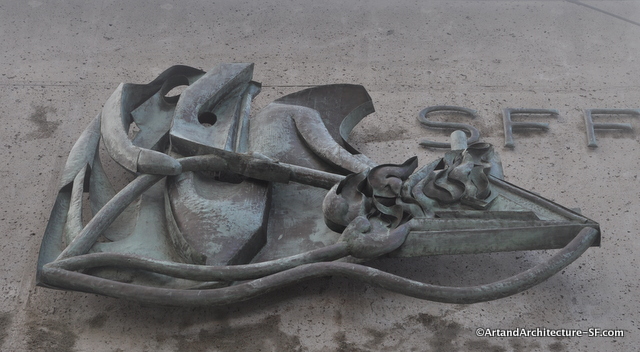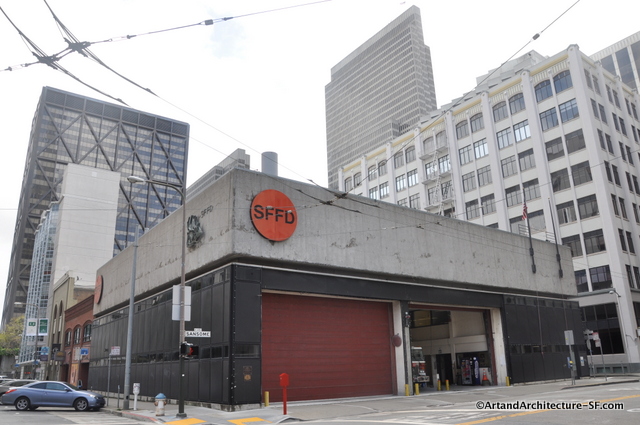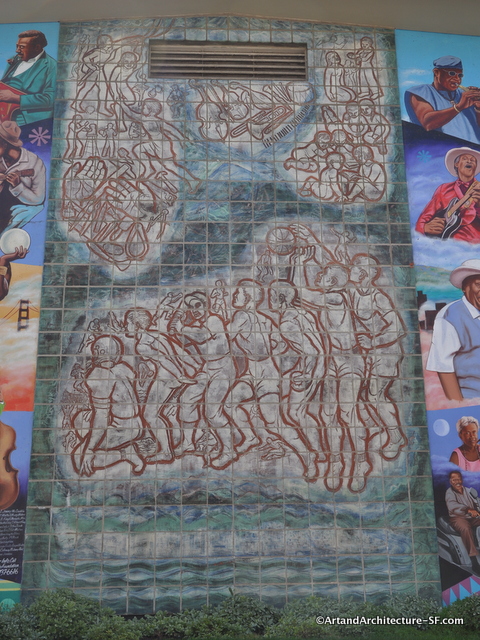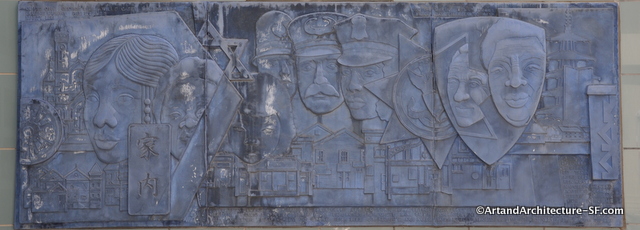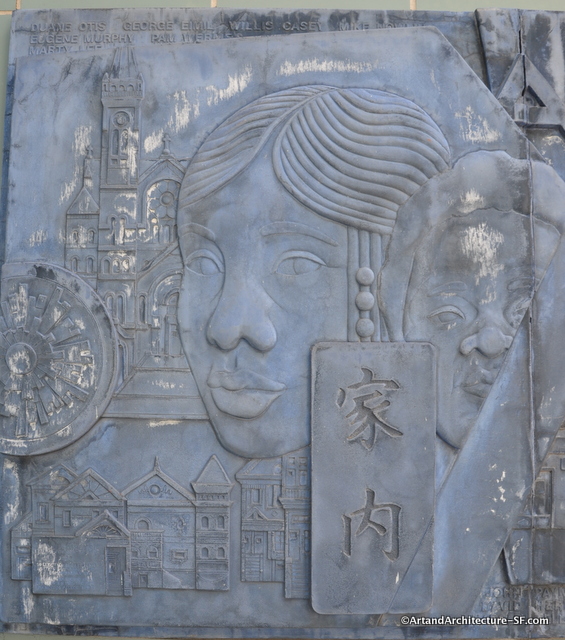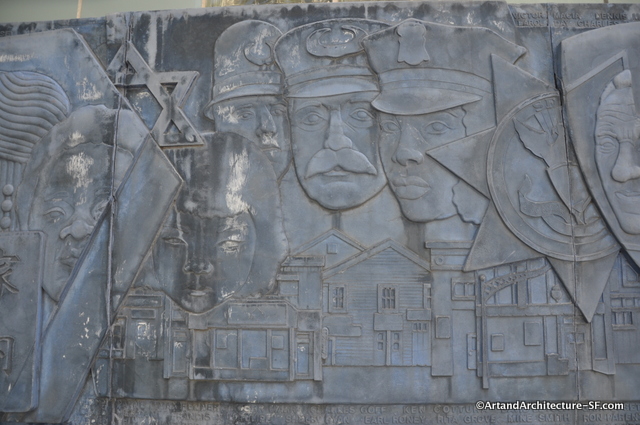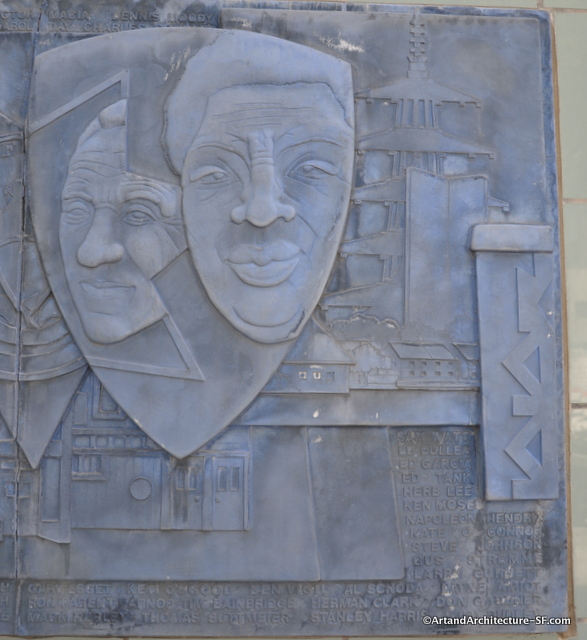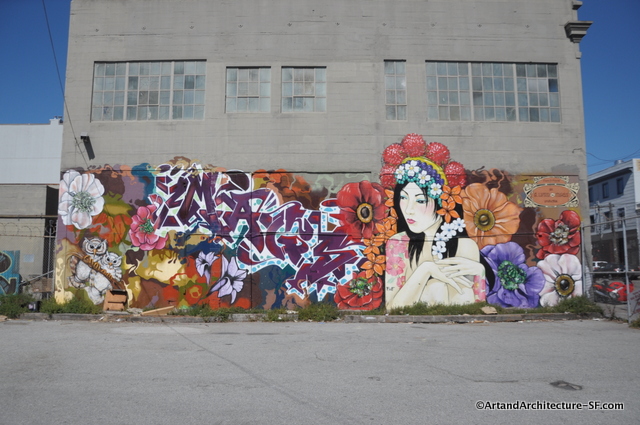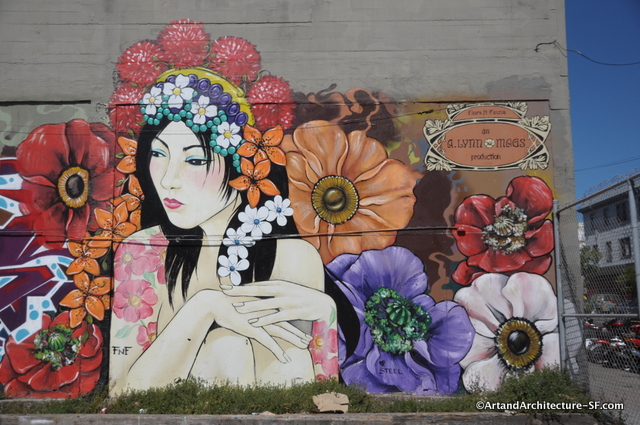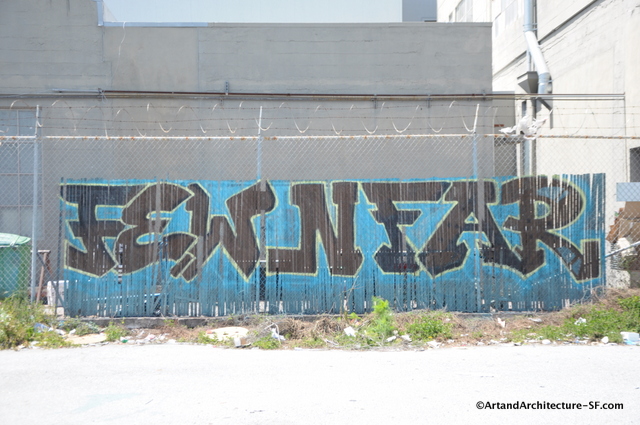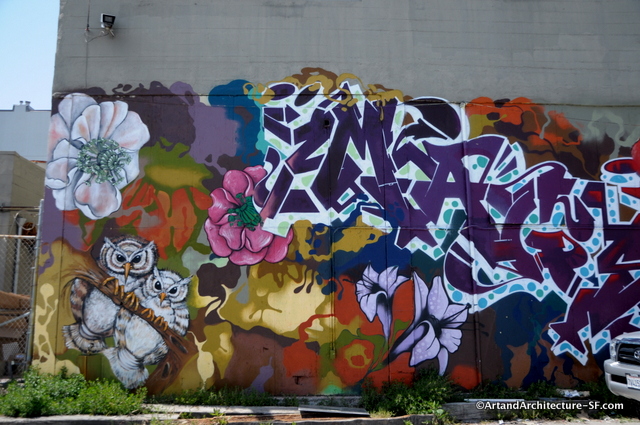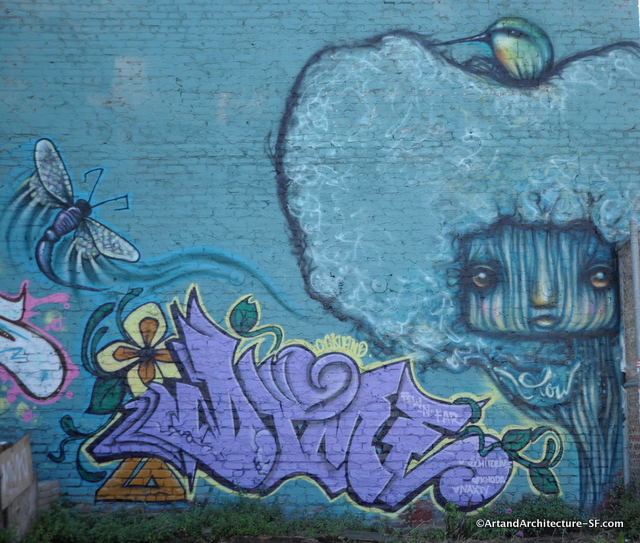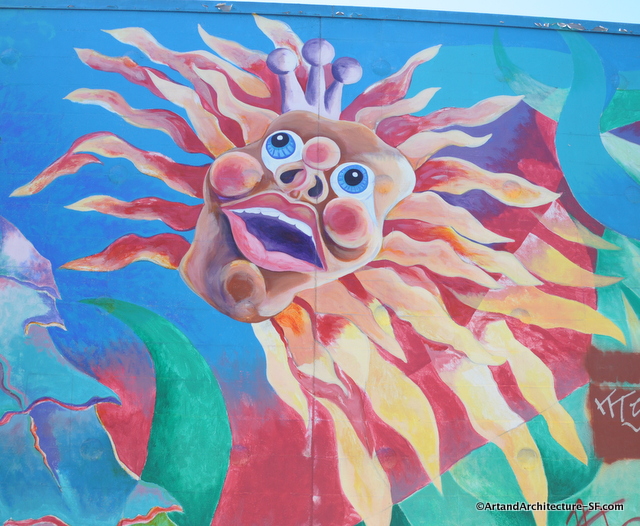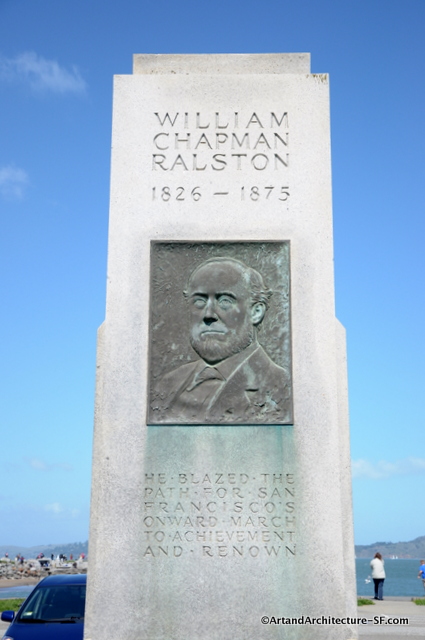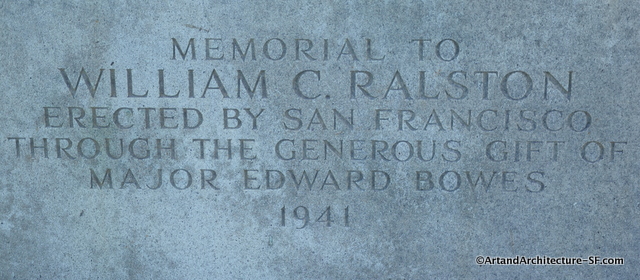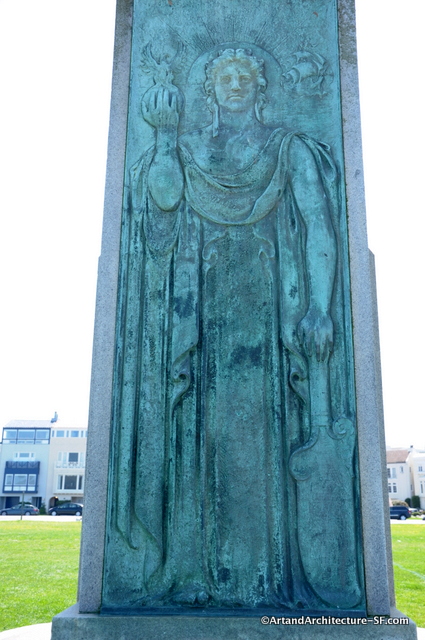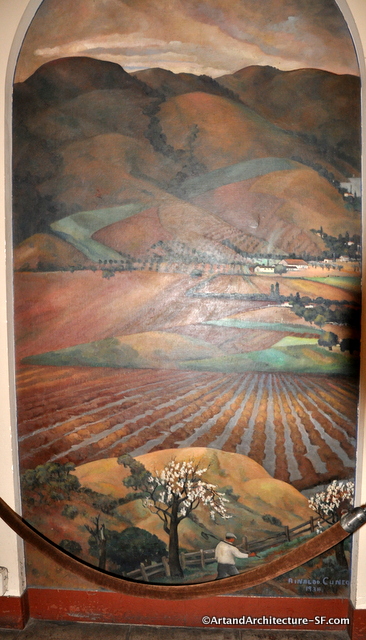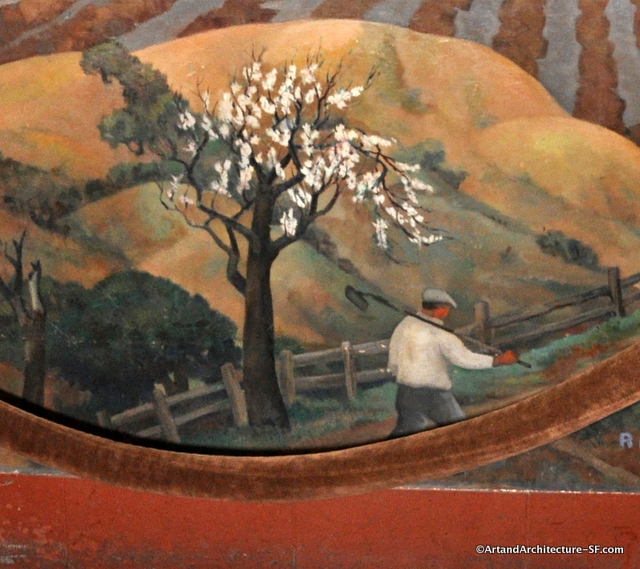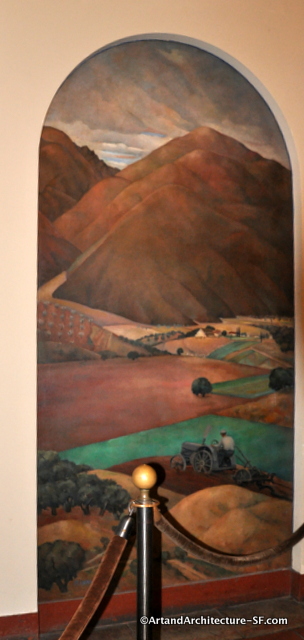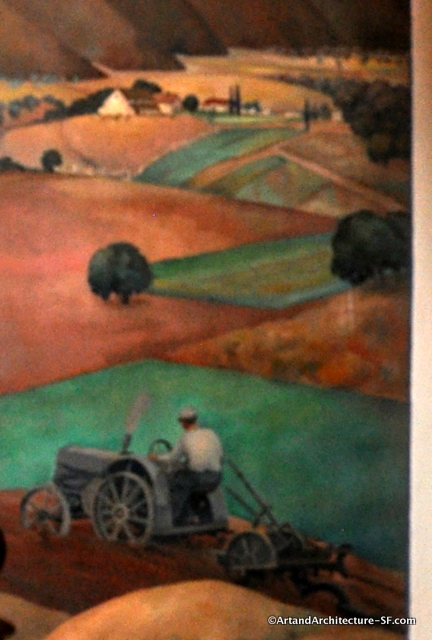This is the image the mural originated from. It is from Ben Hu’s blog I can Cheezburger
Josh graduated in 2003 from UC Santa Barbara, with a B.A. in Studio Art. He is presently a system administrator with AdInfuse in San Francisco.
His website shows the vast array of mediums he enjoys working in. Josh documented a goodly portion of what was going on from beginning to end on his blog. You have to scroll through quite a bit, but it is actually very, very funny and worth the read.
Beginning from the left in New York’s Polo Grounds, the mural shows a line of pitchers as follows: Juan Marchal, Gaylord Perry, and a pitcher from the Women’s League who’s been converted to a Giants player.
At the far right, framing the mural on the opposite side of “the pitch” is Giant hitter Orlando Cepeda. Will Clark hits the home run blast to the left of Cepeda in an earthquake shaken Candlestick Park at the” Battle of the Bay” in 1989.
Other Hall of Famers included in the mural from left to right are: Willie Mays, “The Catch” (in New York), JT Snow (showing some fan appreciation), Barry Bonds (hitting the 756), Willie McCovey and the Alou brothers. The team mascot is Lucille the Seal representing the days when the Giants played in Seal Stadium. Lucille is dressed in a serape and sombrero, holding a maraca to celebrate the Hispanic flavor of the mural.
The Giants community is scattered throughout the mural from the fans to the different stadiums throughout history. Because the mural is being created in the Mission District and home to many Giants fans, the mural also features the Mission Reds, the minor league team from the Mission who played at the Seals Stadium in the 1920’s and 30’s. To the right, between Candlestick and Pac Bell Parks, the skyline of San Francisco embraces a few of the Mission District landmarks such as Mission Dolores, the New Mission Theater marquee and palm trees.
“Vamos Gigantes” (Go Giants) hovers above Seals Stadium and into the Mission, representing the saying, which Hispanic fans have come to use throughout the years.
The future of the Giants is celebrated by the fans, some of which are families and friends. A coach and Jr. Giants’ teammates congratulate their team player with cheers as she hits a winning ball.
The “blast” home run ball hit by Clark is representative of baseball as the fabric of America which weaves into our culture. The ball begins at the hit and moves across the entire mural in a pattern unifying players, fans, the 756 ball, stadiums, and future Giants, morphing into the world and ending with Mays’ famous catch.
In 1980, Richards (a Senior Artist at the Exploratorium for many years) received a planning grant from the National Endowment for the Arts that enabled him to conduct an extensive period of investigation into the physicality of the Wave Organ phenomenon.
The Wave Organ is located on a jetty that forms the small Boat Harbor in the Marina district of San Francisco, walking distance from the Exploratorium. The jetty itself was constructed with material taken from Laurel Hill Cemetery, providing a wonderful assortment of carved granite and marble, which was used in the construction of this piece. The installation includes 25 organ pipes made of PVC and concrete located at various elevations within the site, allowing for the rise and fall of the tides. Sound is created by the impact of waves against the pipe ends and the subsequent movement of the water in and out of the pipes. The sound heard at the site is subtle, requiring visitors to become sensitized to its music, and at the same time to the music of the environment. The Wave Organ sounds best at high tide.
Laurel Hill Cemetery also called Lone Mountain: A “who’s who” of early San Francisco occupied the guest list of the “silent city” including: Andrew Halladie, the inventor of the cable car; David Broderick, the popular US senator, who was killed in a duel at Lake Merced by the Chief Justice of the State Supreme Court; James King of William, whose assassination resurrected the Vigilantes in 1856; Senators Latham, Baker, Sharon, Fair and even Napoleon’s son.
Classical marble tombs and elaborate monuments glorified the affluent departed while a more humble section was reserved for the poor. A vault in the cemetery was devoted to the Chinese, but when “the Chinese must go!” movement gathered steam in 1870s, it was “bespattered with mud and filth, battered with stones and sometimes defaced in a most irreverent manner. The animosity that people bear towards the living, seems to extend even beyond the grave.”
Until Golden Gate Park came of age, Lone Mountain Cemetery served as a park where families would picnic and young couples would promenade among the dead.
Lone Mountain Cemetery was so successful that during the 1860s three other cemeteries were developed to the south, on the slopes adjacent to Lone Mountain. To avoid confusion, it made sense that Lone Mountain Cemetery, which was not located on Lone Mountain, changed its name to Laurel Hill in 1867. Western Neighborhood Projects
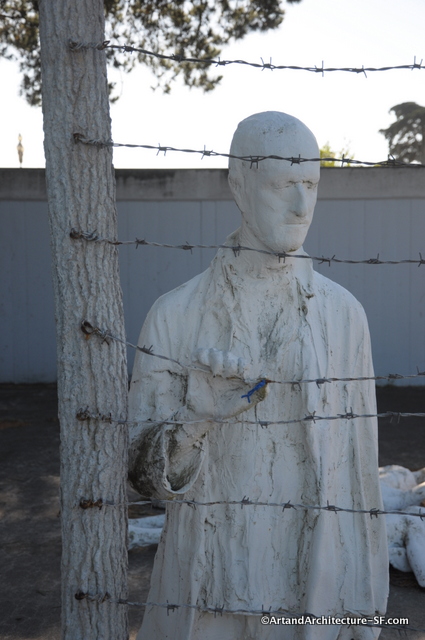 Time has taken its’ toll on this memorial. The hand on the man above was not to touch the wire as they were electrified.
Time has taken its’ toll on this memorial. The hand on the man above was not to touch the wire as they were electrified.
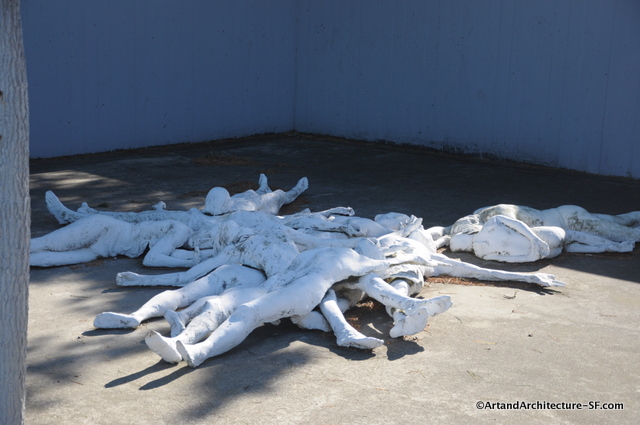 This memorial shows ten figures sprawled, recalling post-war photographs of the camps. Placement of this work was controversial. The choice to look over such a truly beautiful landscape recalling death in a rather graphic way was not acceptable to many. The artist however, insisted that the viewer might consider death while facing towards the monument and life while facing towards the Golden Gate.
This memorial shows ten figures sprawled, recalling post-war photographs of the camps. Placement of this work was controversial. The choice to look over such a truly beautiful landscape recalling death in a rather graphic way was not acceptable to many. The artist however, insisted that the viewer might consider death while facing towards the monument and life while facing towards the Golden Gate.While these are at the Johnson Atelier. Grounds for Sculpture, Hamilton, NJ so the background is different they are the same figures as the FDR Memorial.
This temporary mural was created through twelve workshops with local artists about the nature of compassion. The double portraits depict the artists interacting with themselves in a compassionate gesture of their choosing. The portraits will be left untreated and then washed away before a new one is painted each Thursday in chalk pastel by the artist Evan Bissell.
The participants of the workshop painted the medallions that frame the installation. The symbols contrast with the background drawings that represent challenges to our ability to be compassionate on a personal level as as a society.
The mural is made possible by the Intersection for the Arts, Larkin Street Youth Services and the Tenderloin Housing Clinic.
Bissell is a 2005 graduate of Wesleyan University with a double major in Painting and American Studies with an Ethnic Studies concentration. He was trained in 2011 as a circle keeper by Sujatha Baliga.
Sujatha Baliga’s work is characterized by an equal dedication to victims and persons accused of crime. Sujatha has worked extensively with victims of domestic violence and child sexual abuse as an advocate and board member for rape crisis centers and domestic violence shelters. The convergence of Sujatha’s interest in Tibetan ideals of justice and her work with women accused of killing their abusers drew her to law school and ultimately, criminal defense work. After several years as an appellate public defender in New Mexico and at the Office of the Appellate Defender in New York City, Sujatha relocated to California in 2006 to work on capital cases.
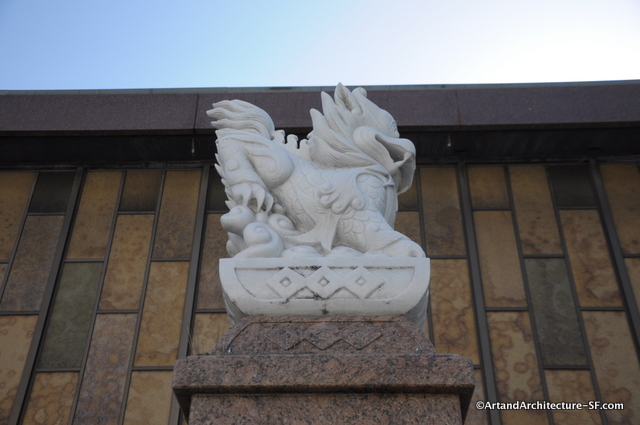 These dragons mark the entrance to a two-block corridor of Larkin Street between Eddy and O’Farrell officially declared Little Saigon in 2004.
These dragons mark the entrance to a two-block corridor of Larkin Street between Eddy and O’Farrell officially declared Little Saigon in 2004.
There are about 250 Vietnamese American-owned businesses in the Tenderloin and eighty percent of the
businesses on the two blocks of Larkin are owned by Vietnamese Americans
The two granite and marble pillars serve as a symbol of peace, happiness and safety for the Vietnamese that have settled here. Most were refugees fleeing persecution by the Communist government after the 1975 war.
Designed by Walter Wong, the pillars weigh eight tons each and are topped by statues of Qi Lun, mythical creatures that are said to bring peace and prosperity.
“Some people wanted our symbol to be a boat to reflect the refugee experience, but this is a business district,” said Tuongvi Tran, who worked with the project for three years and is the executive director of the Vietnamese Elderly Mutual Assistance Association of San Francisco. “The Qi Lun will bring luck and help (the district) grow.”
The project, which took six years to coordinate, was challenged by an initially nonexistent budget. It was only after the Clean City Coalition granted $76,000 of the $108,000 needed for construction to begin that the ball got rolling. Community fundraising covered the rest of the expenses.
On the back in the marble is carved:
Below it is a brass plaque that reads
On the early morning of Sunday September 16th a.d. 1810, Miguel Hidalgo Y Costilla rang the bell of his church in the town of Dolores, in the now state of Guanajuato calling the people to mass and to bear arms against the Spanish yoke of 300 years. The original bell stands now above the central balcony of the National Palace in the City of Mexico where the president rings it at exactly eleven o’clock in the evening of each September 16th in a traditional ceremony called “El Grito” – The “Cry” of Independence
Plaza and monument presented to the City of San Francisco by Lic. Gustavo Diaz Ordaz, President of the United Mexican States September 16th 1966
On May 17th, 2009 the San Francisco Chronicle ran this interesting article:
This seems like heresy, given the apartment prices around Dolores Park, but that gloriously hip plot of land connecting the Mission District to the Castro neighborhood was once deemed “cheap” enough to house the dead. According to Charles Fracchia, president emeritus of the San Francisco Museum and Historical Society, when Dolores Park (then Mission Dolores) was purchased by Congregation Sherith Israel for a Jewish cemetery in 1861, the area was “well out of town.” “There were virtually no residences in around the park,” he said.
Like the 15 to 20 other cemeteries in San Francisco, the graves were moved when property values got too high to justify burial grounds. (Parking lots, on the other hand …) After the city of San Francisco bought the land for nearly $300,000 in 1905, Dolores Park was briefly a refugee territory for people stranded by the 1906 earthquake and the accompanying fires.
Nowadays, the park has become the place to enjoy a sunny afternoon in the Mission. As the wide variety of park visitors indicates – from Latino families to young hipsters to Castro gays – it sits at the intersection of a number of San Francisco demographic groups. And it always has. Fracchia says that even while the park’s two statues – one the Mexican liberty bell and the other of Miguel Hidalgo, the George Washington of Mexico – speak to the Latin American heritage of the area, the immediate environs were a haven for the Irish community for much of the first half of the 20th century. The more things change, the more they remain the same.
Colibri are hummingbirds. They are a medium to large species found in Mexico, and Central and northern South America.
16th Street Mission Station is a BART (Bay Area Rapid Transit) station in the Mission District. It is used by the Richmond–Millbrae line, the Pittsburg/Bay Point – SFO line, the Fremont – Daly City line, and the Dublin/Pleasanton – Daly City line. It is an underground station.
This particular intersection of San Francisco is one of the most crowded and interesting places to visit. It is not the safest or the cleanest, but you will truly find people from every walk of life, dressed in every imaginable outfit, carrying odd things, playing instruments, selling legal and illegal items, and sometimes just hanging out and catching some sunshine.
Victor Zaballa has other metal work in San Francisco. A prolific and fascinating artist Victor Zaballa is an Aztec originally trained in aeronautical engineering in Mexico City. He has lived and worked in San Francisco for a number of years where he is a popular and respected member of the artist community. He works in every medium including cut paper, painting, tile, steel, wood, and wire sculpture, puppet theater, and music composition, performance and musical instrument invention and construction. His performing group “Obsidian Songs,” has been heard in numerous venues throughout California. He has had a kidney transplant and is a very loud voice in the Latina community for organ donation and education.
On May 17th 2003 the Plaza was dedicated to Victor Miller (1948-2002) “Founder and publisher of the New Mission New, the voice of the Inner Mission for over 20 years. Victor was a tireless advocate and watchdog for the community whose vision and journalistic skills provided the most perceptive and trustworthy observations of the Mission Neighborhood.”
New Mission News
Comforting the Afflicted and Affecting the Comfortable since 1980
1000 The Great Highway
This memorial sits in the parking lot of the Beach Chalet, it has been there since 1930. It marks where Amundsen’s ship, the Gjoa (pronounced “Joe”) was in dry-dock. It had been pulled ashore here in 1909, and placed on dry-dock display. Amundsen donated the ship and the Norweigan community took up a collection to display the ship in the park. Unfortunately, the ship had a rough time and had fallen into disrepair by the 1930s due to vandalism and the elements. The Gjoa Foundation was formed in 1940 to restore her but was thwarted by the outbreak of WWII. A restoration took place in 1949, but a sever gale in 1960 toppled the uppermost part of the mast, and by 1970, years of neglect had taken their toll. In 1972 she was hauled to Pier 48, loaded on a freighter and sent to Oslo, Norway, where she was lovingly resorted and draws thousands of visitors a year.
Roald Amundsen was one of the world’s most important explorers. Between 1903 and 1906 his crew were the first to navigate successfully the Northwest passage, from the Atlantic to the Pacific. Along the way Amundsen’s expedition had determined the position of the Magnetic North Pole. And the epic adventure was completed when his 69-foot sailing ship entered San Francisco in 1906. Its arrival was greeted with great celebration and acclaim.
Amundsen later became the first to reach the South Pole, in a larger ship, the Fram, and he was quite a successful lecturer and writer. His scientific contributions and adventures are graphically recounted in such books as the North West Passage (1908), The South Pole (1912), The North East Passage (1918 -1920), Our Polar Flight (1925), First Crossing of the Polar Sea (1927), and My Life As An Explorer (1927) It’s the Northwest Passage journey of the Gjoa, however, that connects Amundsen to San Francisco.
The sculptor was Hans Jauchen, born in Hamburg, Germany of Danish parents who were famous artists themselves. He immigrated to the US in 1910 and began teaching at Stanford, UC Berkeley and other institutions. His studio – Ye Olde Copper Shop – on Sutter street, provided sculpture services, and ornamental bronze and iron works. One of his most notable works is an altar depicting scenes in the life of Christ, commissioned by financier J. Pierpont Morgan, Jr. for his London home.
Lucien Labaudt’s Beach Chalet murals: John McLaren (G.G. Park Superintendent) in left foreground on bench, with Jack Spring (later General Manager of Parks and Rec Dept.) holding redwood tree’s root ball, while behind on horseback (upper right corner) sit sculptor Benny Bufano and Joseph Danysh, then head of California Federal Art Project.
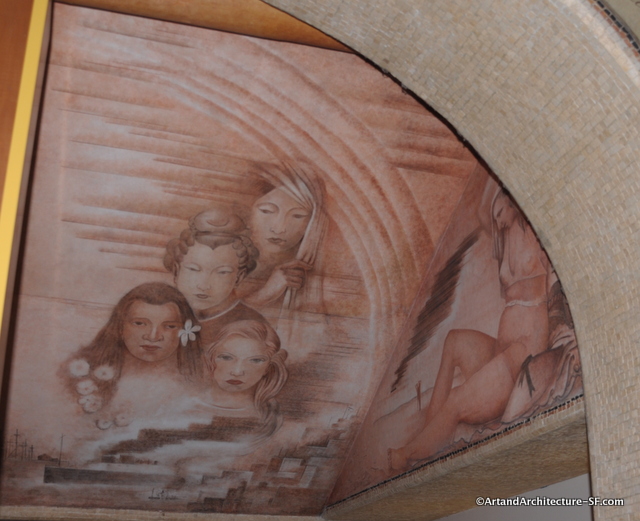 There are a few monochrome murals under the stairway they are also by Labaudt.
There are a few monochrome murals under the stairway they are also by Labaudt.
It was common for WPA muralists to place people they knew or people of note in their work. Here Lucien Labaudt inserts Arthur Brown Jr.. Brown was the Architect of City Hall (shown over his left shoulder) and architect of Coit Tower, where Labaudt worked as well.
The Beach Chalet has its own fascinating history. This is however, about the WPA work found at the Beach Chalet.
All the murals in the Beach Chalet were done by one artist, Lucien Labaudt. Born in France, he came to the United States in the early 1900s. He was an accomplished dress designer to the rich and famous of San Francisco High Society. He is responsible for decorating the curved walls in Coit Tower with frescoes (these frescoes are not available for public viewing). In 1936 he painted Advancement of Learning throughout the Printing Press, a fresco at George Washington High School. When asked about the limitations WPA art often came under he wrote “limitation forces one to think and therefore to create…Far from destroying the artist’s individuality, these limitations give him something to fight for. He must solve a problem. ” Labaudt died in a plane crash over Burma in 1943, on assignment to do war sketches for Life Magazine.
“San Francisco Life” is the title of the frescoes covering three walls of the first floor of the Beach Chalet. The mural depicts four San Francisco tourist locales: the beach, Golden Gate Park, Fisherman’s Wharf, and the Marina. Recognizable figures of the time from the arts and politics are shown in the mural scenes, engaging in leisure activities. Since Labaudt painted the mural in 1936-37, during the Great Depression, such leisure would have actually been out of reach for most people. Showing high-profile figures, including WPA administrators, enjoying their leisure time, was most probably a political comment on the inequalities of the times.
Born, Beniamino Bufano, in San Fele, Italy, in 1886, he was one of sixteen children. His family immigrated to New York when he was three, and at six he began contributing to the family income by shining shoes and peddling newspapers. He dropped out of school after the third grade, but entered art school as a teenager, working there as a janitor in lieu of tuition. Later he became apprenticed with the sculptor James Frasier, while he continued to work as a janitor.
In 1915, a fellow sculptor, who’d been selected to create works for the Panama Pacific International Exposition, offered Benny a job as his assistant. Once in San Francisco, Benny’s talents were recognized, and he began receiving regular and lucrative commissions. Saint Francis is the patron saint of San Francisco. Born Giovanni Francesco di Bernardone; 1181/1182 – October 3, 1226, Saint Francis was an Italian Catholic friar and preacher. He founded the men’s Franciscan Order, the women’s Order of St. Clare, and the lay Third Order of Saint Francis. St. Francis is one of the most venerated religious figures in history. The statue was brought to Fisherman’s wharf to stand a few yards from the Longshoremen’s Memorial Building honoring famed unionist Harry Bridges.
The statue stands 18 feet tall and weights 12.5 tons. In 1928, while the statue was being exhibited in Paris, where Bufano sculpted it, the late English art Critic Roger Fry wrote that is was “the most significant piece of sculpture done within 500 years.” The statue was brought to San Francisco in 1955 through the efforts of Bufano’s close friend Paul Verdier, owner of the City of Paris department store, mayor Elmer Robinson and the French government. San Francisco is lucky to have many of Bufano’s pieces scattered throughout the city, here are a few others.
Three firemen grouped on a circular base, are standing, dressed in uniform. Two have hats on. One firefighter carries a woman in his arms; another holds what appears to be a bullhorn, and the third (behind the other two) holds a firehouse.
This statue was paid for by a portion of the monies left behind by Lillie Hitchcock Coit.
“Maru” means “circle,” the word is frequently added to names of Japanese ships “as a way of blessing the vessel, wishing it safe travels and a safe return to port, thus closing the circle.
There are two sculptors listed for this monument. Mitsui Nakai and Ishi Katsu.
I am sharing with Sundays in My City
The stone reads: We are grateful, as we stand facing this monument, for the infinite gifts of heaven and earth. We recognize once again the true fundamental of the human should that pursues the truth, implements the good, creates beauty, and renews his will to step forward. This way brings about peace in mind and on earth by mutual understanding, encouragement and help. It was in this spirit that this monument was built.
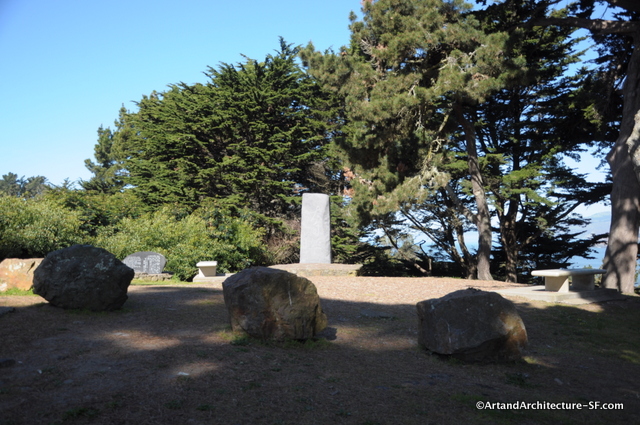 This piece is owned by the San Francisco Parks and Recreation Department. According to a Japanese Encyclopedia, Bundo Shunkai (1878-1970) was a Calligrapher and Buddhist monk, Sojo (bishop) of the Tendai sect. He was a student of Nishikawa Shundo. His style was flexible yet firm.
This piece is owned by the San Francisco Parks and Recreation Department. According to a Japanese Encyclopedia, Bundo Shunkai (1878-1970) was a Calligrapher and Buddhist monk, Sojo (bishop) of the Tendai sect. He was a student of Nishikawa Shundo. His style was flexible yet firm.
Henri Marie-Rose (1922-2010) born in François, Martinique, the son of Appien Constance Raymonde and Quentin Joseph Marie-Rose Dite Cétoute, Henri Marie-Rose Dite Cétoute, who later simply went by Henri Marie-Rose, was a San Francisco resident for 58 years, living initially in North Beach before settling on Potrero Hill.
He attended the École des Arts et Métiers and the École des Arts Appliqués in Martinique. He had three one man shows in 1940, 1942 and 1943 and was appointed Attaché Culturel au Projet d’Urbanisme,
Shortly thereafter, he was awarded a scholarship by the French Government to study at the École National Supérieure des Beaux Arts in Paris, but got only as far as North Africa when the Second World War broke out.
Eventually Henri studied at “Beaux Arts” for over eight years. During this period, he met an art student, Marjorie Raitt, who was attending the Sorbonne and the Académie Julian, having recently graduated from Stanford. The couple married in 1952 and traveled by freighter to San Francisco the following year. Within weeks of his arrival, he won the Emanuel Walter Purchase Prize, & later hosted an 18 week series on KQED entitled “Techniques in Sculpture”. In 1960, his work was exhibited in a one man show at the De Young Museum. He went on to exhibit across the country & in Brazil. He spent his final 12 years as a teacher & mentor for Recology’s Artists in Residence Program.
This piece is copper and is part of the San Francisco Civic Art Collection.
*
This cast concrete panel by Horace Washington depicts the cultural diversity of the Western Addition and its architectural history. The panel also features the likeness of police officers of the past. The piece is part of the San Francisco Arts Commission collection and was produced in 1987. It is 3 feet high by 8 feet long.
Horace Washington (who has work on the 3rd Street Light Rail project) studied at Columbus College of Art and Design in Ohio before moving to California to study sculpture at the San Francisco Art Institute and then completed his graduate studies at Cal State University, Sacramento. He is a San Francisco sculptor and muralist whose works include numerous projects in a variety of materials for public facilities in northern California including the International Longshoremen’s & Warehousmen’s Union mural/ scultpure, the Northern Police Station sculpture, the Martin Luther King Swimming Pool Tile Murals, and the Plaza East ceramic tile and painted mural. He exhibits his work in San Francisco and has been a guest lecturer at UC Berkeley, Cal State Sacramento, and for the San Francisco Unified School District. He has also taught developmentally disabled adults at the Creativity Explored Art Center. He lives and works in San Francisco.
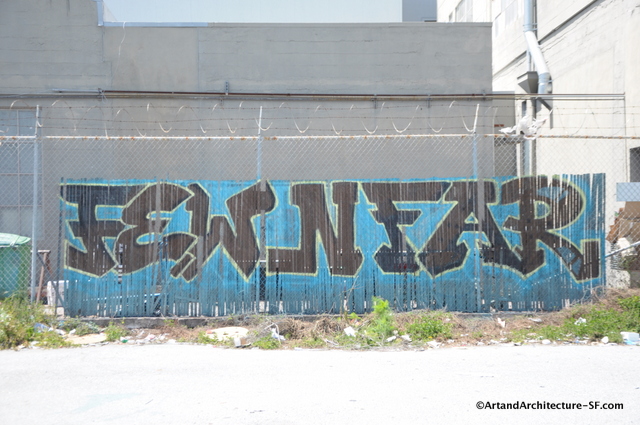 Continuing with the Few N Far Crews work at 69 Duboce.
Continuing with the Few N Far Crews work at 69 Duboce.
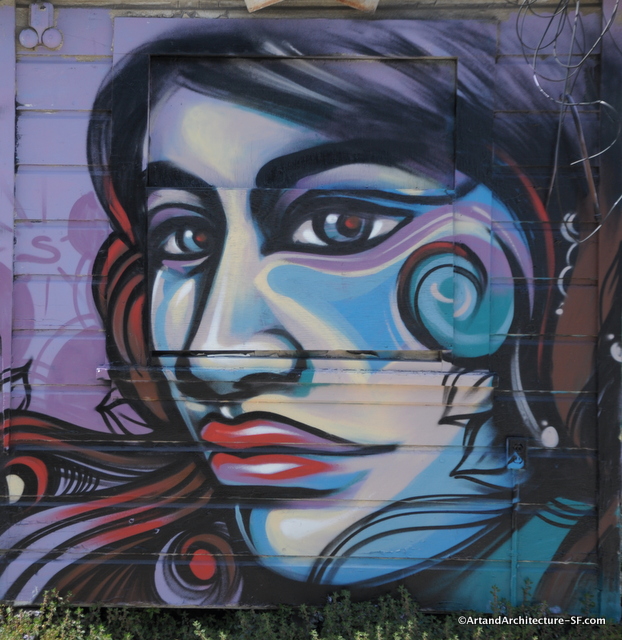 Meagan Spendlove – Meagan has murals all over town.
Meagan Spendlove – Meagan has murals all over town.
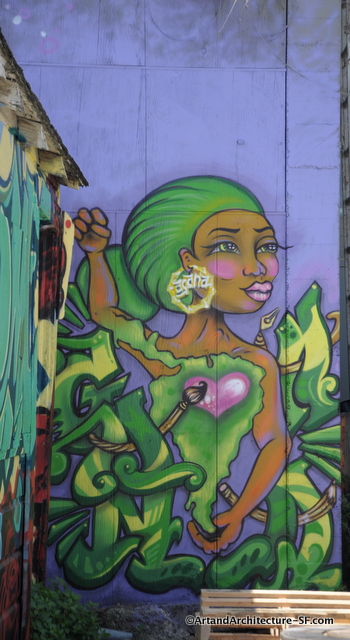 Agana is from Oakland. From Few and Far’s Website: Agana is not only a bad ass DJ but she is an art teacher, muralist, jewelry maker, loving/giving friend, always down to paint no matter what!! Agana also films and edits her own videos.. Oooh yes, don’t let me forget to mention… she always has her nails on point every time!
Agana is from Oakland. From Few and Far’s Website: Agana is not only a bad ass DJ but she is an art teacher, muralist, jewelry maker, loving/giving friend, always down to paint no matter what!! Agana also films and edits her own videos.. Oooh yes, don’t let me forget to mention… she always has her nails on point every time!
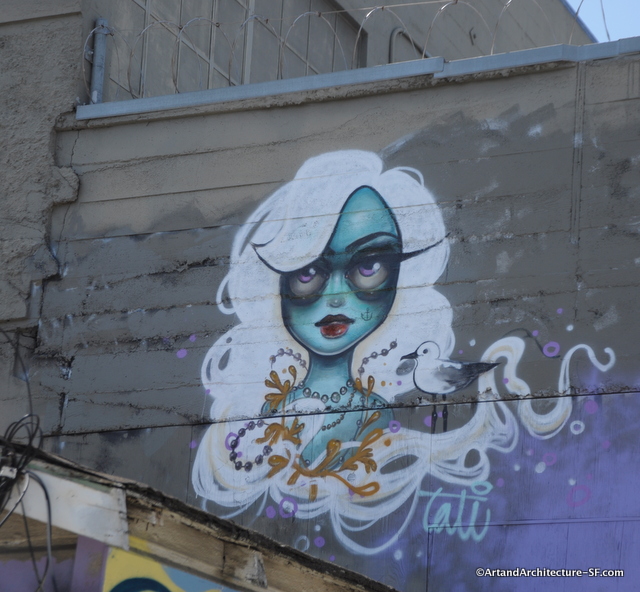 Tatiana Suarez is from Miami and New York. According to Tati’s website: Tatiana Suarez (b. 1983) is a Brooklyn-based Miami native. Her charming style is distinctive — first, the trademark eyes that draw the viewer into a beautiful and surreal world. Suarez takes full advantage of the oil paint’s ability to create creamy, soft images on canvas. Rich with symbols that stem from her Brazilian and El Salvadorian heritage, subjects appear as if they are under water, frozen in lovely stillness. The doe-eyed figures look childlike, but also exude sexual overtones, ornamented with plants, insects and other unsettling accompaniments. Beauty is presented concurrently with exotic — even creepy — creatures to create enchanted narratives.
Tatiana Suarez is from Miami and New York. According to Tati’s website: Tatiana Suarez (b. 1983) is a Brooklyn-based Miami native. Her charming style is distinctive — first, the trademark eyes that draw the viewer into a beautiful and surreal world. Suarez takes full advantage of the oil paint’s ability to create creamy, soft images on canvas. Rich with symbols that stem from her Brazilian and El Salvadorian heritage, subjects appear as if they are under water, frozen in lovely stillness. The doe-eyed figures look childlike, but also exude sexual overtones, ornamented with plants, insects and other unsettling accompaniments. Beauty is presented concurrently with exotic — even creepy — creatures to create enchanted narratives.
69 Duboce
Between Valencia and Mission
This is an empty lot that was taken over (with permission) by Few and Far. Few and Far is a woman’s street art group and this is what they say about themselves on their blog:
Few and Far is a movement that brings together talented women who are involved in graffiti, Skateboarding and street art from all over the world. Few and Far connects women by creating social and artistic exchange, by showcasing art on the streets, on walls and in other high profile venues. Few and Far fosters and celebrates the power and expression of female street artists. Importantly, Few and Far consists of a team of open minded, highly creative, cutting edge and dedicated every day females. We seek to expand this movement with the involvement more around the globe, and hope to highlight their commitment to their craft. Also Building life long friendships.
The group is made up of a quite a number of women.
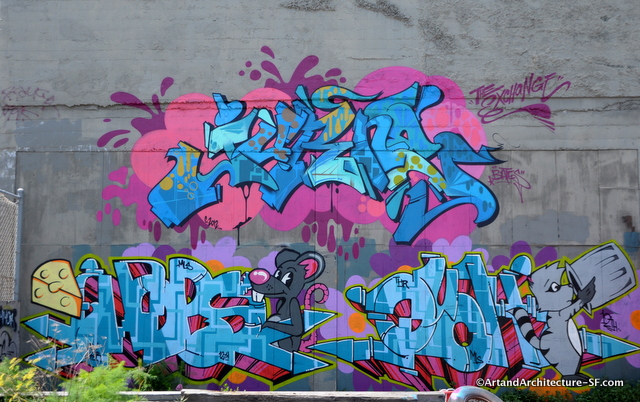 Hops is from Seattle. (From Few and Far’s Blog) Few & Far’s Hops is such a dope person on many levels. She is very motived, fast and clean painting, often finished before any of us have our final outlines up. She paints anything she gets her hands on!
Hops is from Seattle. (From Few and Far’s Blog) Few & Far’s Hops is such a dope person on many levels. She is very motived, fast and clean painting, often finished before any of us have our final outlines up. She paints anything she gets her hands on!
Joshua, a Minnesota resident, is a truly prolific muralist. Joshua Sarantitis has been creating monumental professional work in public spaces for over 20 years. His 40 commissioned works include glass installations and mosaic murals located regionally and abroad including San Francisco, Chicago, Philadelphia, Cleveland, Los Angeles, Minneapolis, Phoenix and Tucson. His ability to collaborate successfully with design professionals, arts administrators and community is rooted in a desire to find common language between our everyday lives and the arts. Joshua embraces using technology as a tool to aid in mastering media including slumped and fused glass, mosaic, plasma-cut steel, concrete, glass frit, ceramic toner on glass, ceramic tile and paint and fiber. He combines the desire for learning with the skilled execution of an accomplished technician.
This was one of Joshua’s first murals. It was done in conjunction with Precita Eyes. It was funded by P.G.&E., The Neighborhood Beautification Fund, and the Graffiti Clean Up Fund.
The San Francisco Mission District has been hosting a Carnaval Festival since 1978. There is a very elaborate parade, afterwards streets are blocked off and food and entertainment can be enjoyed to ones hearts’ content.
This statue to Ralston was commissioned and paid for by Edward Bowes(14 June 1874, San Francisco – 13 June 1946, Rumson, New Jersey) Bowes made his fortune in real estate in San Francisco. The 1906 earthquake made him reevaluate his life, he moved to New York and became involved in the entertainment industry. Major ( a rank he obtained in WWI, and insisted on being addressed this way for the rest of his life) Bowes’ Amateur Hour was the best-known amateur talent show in radio during its eighteen-year run (1934-1952) on NBC Radio and CBS Radio.
This is the last in a series of the murals of Coit Tower. There are more, unfortunately, they are not available to the public. If you are interested in seeing pictures of them, and learning more about Coit Tower and all of the murals, I highly suggest you search out Masha Zakheim’s Book Coit Tower.








